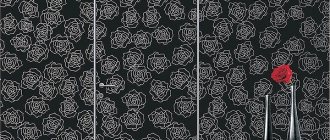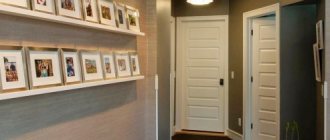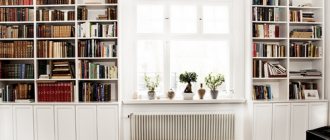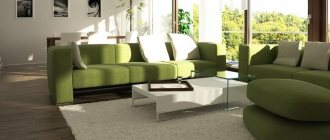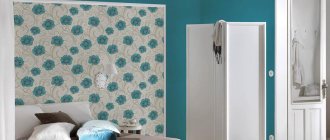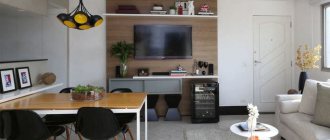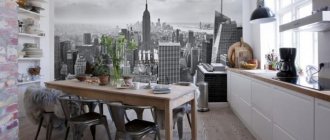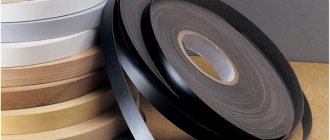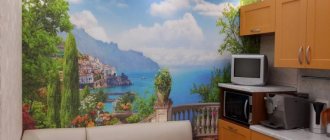At the stage of decorating walls with wallpaper, it is very important to determine the starting point from which work will begin. The aesthetic appearance of the renovated room depends on how correctly the location of the first strip is chosen. Any room has its own nuances - various lighting sources, design features - niches, ledges, corners, window and doorways. In addition, there are certain requirements for the installation of various types of wallpaper - paper, vinyl, non-woven. Only after all the individual characteristics of a particular room and the material used are taken into account can you decide where to start gluing wallpaper. Let's consider various methods that may be suitable in a given case.
Why is it important to decide where to start gluing wallpaper?
The starting point will become a reference point for the following fragments. If the first piece comes out unevenly, the remaining pieces will be unsuccessful and the joints may not meet. It is worth familiarizing yourself with the places where you can start working and get a decent result.
With joining materials, it is not critical to start covering from any place (preferably inconspicuous), but there is a likely risk of unevenness and alteration of the area.
Consistency plays an important role in repairs. Chaotic finishing will lead to inconsistencies.
What else to pay attention to
To avoid additional problems, you need to consider the following points:
- The relationship between adjacent corners and the door.
- The location of window openings relative to each other, the entrance to the balcony.
- Placement of heating elements: pipes, radiators, etc.
- Arrangement of furniture.
- Availability of other important interior details.
If the room has a stationary cabinet that is not planned to be moved to another place in the future, you can start gluing from it, so that the junction of the strips is hidden behind it. The same applies to the furniture in the kitchen.
Options for starting wallpapering
To ensure that the coating lays flat, without air bubbles and unevenness, evaluate the position of the room (lighting, openings, protrusions). In some rooms it is better to choose coverage from the center or corner of the wall.
From the window
Previously, the wide range was mainly for thin wallpaper, which was applied overlapping. To prevent shadows from appearing in the seams, it was customary to position the canvas away from the light, i.e. from the window. Another reason for pasting from a window opening was the straightness of the line, since doorways and corners were more likely to warp.
From the window, wallpaper can be glued in a circle or on both sides, placing the joint under it. Subtle variations are overlapped.
Properly glued wallpaper creates a single canvas. When the pattern does not match at the joint near the window, it is easily hidden behind the curtain.
From the door
Starting pasting from the doorway is suitable for a corridor, toilet or hallway, where there is a natural source of light and there are no other suitable landmarks.
Prints with patterns begin to be glued from the openings so that there is no need to adjust the pattern.
Irregularities are hidden behind the door.
Glue wallpaper in two directions or sequentially. To do this, mark a joint above it, and continue the repair in a circle.
From the corner
The most problematic and complex coating method. The problem with pasting from corners is the unevenness of the area. Method used:
- if there are no windows;
- the doors are warped;
- According to the plan, there are two types of wall coverings in the room.
You need to start gluing with a distance of 2-3 cm from the corner.
In two directions at once
If there are two doors or several windows in the hall, determining the landmark becomes a problem. In this case, choose a larger landmark and move in a circle.
The kitchen is papered using the same method.
The radiator is considered a hard-to-reach place for pasting. There are two ways to install fragments behind the battery:
- Remove the material and glue it carefully. To do this, turn off the water and drain the liquid. It is advisable to call a professional to avoid damaging anything.
- An alternative option is to glue the canvases one by one. The process will take no less time than removing the radiator, and it will be difficult to match the pattern.
Other landmarks
Thick wallpaper should only be glued end-to-end; it can be distributed from:
- arches or similar sized structures;
- inconspicuous areas;
- kitchen unit or under the radiator;
- far corner (the gaze is focused on a flat canvas);
- a corner located close to the balcony;
- far inner corner (trellises - vinyl).
From the window
The old Soviet method is still used, often, despite the ability of modern wallpaper to create a seamless finish. The method is popular because people are used to working this way, and the older generation advises the younger generation to do so.
The second reason: Soviet windows were smooth, unlike doorways or corners, the curvature of which is sometimes visible to the naked eye. Another advantage of this method: the window opening, as a rule, is deformed very slightly and is quite suitable for reference.
And one more argument in favor of the window opening. When gluing from another point, when it comes to the window, the solid canvas will most likely not fit near the opening and you will have to cut off a strip of the required width.
In addition, gluing wallpaper under the window is usually very difficult, since heating radiators are usually located there. If work starts from the window, these problems can be avoided.
How to properly start wallpapering a room with uneven corners
Uneven corners are a common problem in residential areas. It will not be possible to fix them without a builder. There are subtleties to visually eliminating a defect. Proper coating will save you from having to redo the wall covering for a long time.
It is not recommended to apply geometric wallpaper. On the contrary, they will highlight the shortcomings of the room. An alternative solution would be abstract types with increased density. It is better to replace smooth ones with textured ones with blurry patterns. Correct markings will help complete the repair successfully. It is important to take into account all the irregularities, holes for sockets and other details.
To apply the canvas without aligning the corners, you must adhere to the following order:
- Check the deviation of the angle from the straight line. Visually the line will be smooth, but you should not neglect the measurements. A crooked wall will cause the wallpaper to warp. The most accessible measurement method is a plumb line or building level. It is preferable to choose a longer tool. The most accurate result will be shown by a laser level. When gluing end-to-end, the starting point will be the doorway, when using a thin trellis - from the window. Vinyl and other dense fabric are distributed from the corner (the thicker the wallpaper, the more glue is required for fastening) with an overlap of 5-10 cm on the adjacent wall, cutting slots along this area in a herringbone pattern. This will ensure a tighter fit of the wallpaper.
- It is worth noting that non-woven variations can stretch and hide small depressions. The wall is first treated with glue. The first layer is a primer, the second is for fastening. After which the dry canvas is glued to the wall.
- Before starting to apply the fragment, apply a tape 15-20 cm wide or a painting mesh to correct the surface. In this case, the gaps formed by the slits will be hidden.
- Glue is applied to the wall and roll and allowed to dry.
- A bend strip corresponding to the angle is drawn on the incoming material. This part is cut off with a stationery knife, the joint is not noticeable.
- The second fragment is overlapped, the subsequent fragments are placed end-to-end.
From the door
Currently, builders, as a rule, strictly monitor the verticality of doors and corners. Unpleasant exceptions do occur, although they are rare. It is convenient to glue wallpaper from the door for the following reasons:
- the first and last strips do not have to be joined together;
- in areas such as a hallway or hallway, the doorway is often the only suitable landmark.
- if there is an unevenness somewhere, the door will cover it. This option is optimal when the pattern on the stripes must converge exactly.
It should be noted that even a very smooth-looking doorway will not hurt to check it once again with a good building level or plumb line.
Tips and tricks from experts
It’s not difficult to hang wallpaper yourself if you carefully familiarize yourself with the work to be done and prepare the necessary materials. To save effort and time, experienced craftsmen have prepared several tips.
Wallpaper is glued for a long time, and there is no need to rush in this matter. If they are being remodeled, the old materials are removed, leaving bare walls. The material is moistened with water and scraped off with a spatula. When hot water does not cope, use a needle roller.
The clean wall is treated with antifungal agents and allowed to dry.
Remove the top layer from the painted wall using a drill with sandpaper or a chemical solution. Uneven places are leveled with putty (spotwise or entirely). The dried surface is treated with sandpaper and any remaining dust is removed.
Remove furniture from the room so that nothing restricts movement. The walls must be empty. Turn off the electricity, unscrew the sockets and switches. You need to stick wallpaper on the holes. When finished, carefully cut out the connectors and screw them back.
Pasting can begin from the corner. The fragment is placed a few centimeters from this zone. Starting work in a corner is only permissible using bright materials. They hide imperfections and visually expand the space. When finishing a door or window, it is recommended to first pay attention to the walls above and below the window, as well as above the doors. To glue the non-woven fabric, you need at least two people. Friends or relatives will help speed up the process and accurately carry out the planned repairs, since heavy rolls must be controlled along their entire length.
Gently brush or spatula over the surface, getting rid of air bubbles.
Do not cut the roll into equal parts. The measured area may differ from others. Add 1 more roll to the calculated amount of material (some fragments deteriorate during operation).
If the wallpaper is thin, it is recommended to overlap it in a left-to-right direction.
You can make a plumb line for measuring a flat vertical with your own hands; to do this, drive a nail near the wall or under the ceiling, onto which a meter-long rope is tied. A weight is tied to a rope above the floor. The wall is illuminated with a flashlight, and a straight line is drawn along the formed shadow.
Preparatory stage
The preparation of walls in a new building and a residential apartment are somewhat different from each other. In a residential apartment, work begins with dismantling the old type of finishing: paint, whitewash, old wallpaper. After this, the walls are inspected. If necessary, the old plaster is removed and the walls are repaired.
In the new building, installation work is being completed on installing door and window units, wiring, pouring floor screed, and whitewashing the ceiling. After this, the work in both the new apartment and the old one is the same:
- the surface of the walls is prepared for applying plaster: notches are made, primed, beacons are mounted;
- the walls are plastered with gypsum (cement-sand) mortar or dry plaster (OSB board, plasterboard, plywood);
Attention: rooms with high humidity - bathroom, kitchen and toilet - are prohibited from being plastered with a solution containing gypsum.
- the plaster layer is puttied (if the finishing grouting is done at a high level, and the wallpaper is planned with a relief pattern, the operation can be skipped);
Important: a thin layer of putty must be applied to the plasterboard, which will allow you to subsequently remove the pasted wallpaper without destroying the plasterboard sheet.
- a primer is applied to ensure adhesion of the wallpaper glue to the wall.
The entire process of preparing walls for wallpaper is discussed step by step in the articles “How to prepare walls for wallpapering” and “How and what is the best way to prime walls before wallpapering.”
Video: from which part of the room should you start wallpapering?
Before starting work, it is recommended that you familiarize yourself with the video, which explains in detail the general process of preparation, selection of tools and subtleties when working with wallpaper:
You don't need professional experience to hang wallpaper. The main rule of every repair is patience and attention to detail. It is worth following the recommendations, exploring the room and deciding on a starting point. If the roll has a pattern, each fragment is adjusted to the previous one to form one picture.
How to hang photo wallpaper
There are situations when the old finish does not need to be removed, for example, such as gluing photo wallpaper to a wall with wallpaper. In this case, a number of rules must be followed:
- The relief of old wallpaper should not be more than 0.2−0.3 mm.
- Photo wallpaper must have a high or ultra-high density.
- Pasting is only possible on waterproof wallpaper in good condition.
Then the leveling and puttying of the walls begins. Cover deep cracks with the solution; you can ignore small ones; they will be smoothed out when puttying. Putty walls must be primed. This is where the main preparation ends, don’t be too lazy to do all the preparatory part, because this will determine how quickly you hang the wallpaper.
The advantages of combining in the corridor
Not everyone can boast of a stylish hallway or hallway interior, and with the help of basic combination techniques you can achieve an original effect without resorting to additional help.
In addition, there is always the opportunity to implement ideas from a photo of the design of combined wallpaper for a corridor, having previously assessed all the advantages and disadvantages of this style.
Common combination methods have found their application in many interiors due to the huge number of positive properties:
with the right combination of shades and patterns, you can transform the shape and size of your corridor. For example, stripes have the effect of lengthening, so plots with vertical lines raise ceilings, and those with horizontal ones expand walls. Scenes with large prints visually reduce the space, and the use of photo wallpaper with a realistic pattern in the corridor will help you make the room more spacious;
By gluing dark wallpaper to the lower part of the walls, you can provide additional protection against periodic dirt. In addition, this method is considered effective due to the fact that it provides a balance between dark and light shades in space; Using wallpaper of an unusual texture, a bright shade or a large pattern, you can create an accent on one of the walls. This will allow you to highlight the main part of the corridor and draw maximum attention to this area. Most often, this effect is carried out to highlight niches, areas with mirrors or small shelves. combined wallpaper in the hallway is a great opportunity to emphasize the style of the room. For example, scenes with floral patterns will emphasize the natural theme in the interior, and strict stripes will demonstrate your interest in the classic style.
Creating combinations in the hallway will allow you to achieve another effect - to ensure a smooth transition to neighboring rooms, and each of your family and guests will be able to enjoy the pleasant appearance of such an interior.
Types of lathing
Let's move on to installation and start with choosing the sheathing. The sheathing is made from:
- wooden beams;
- profiles for fastening drywall;
- metal U-shaped profiles for siding;
- plastic structures designed for the installation of vinyl and acrylic panels.
Before installing the sheathing, inspect the surface. If there are cracks, crevices and other defects on it, they need to be repaired. If the old cladding is crumbling (for example, paint or plaster), it must be removed. If there are strong differences and unevenness on the walls, they should be smoothed out. Otherwise, the geometry of the wall will be disrupted and the siding may crack or deform.
After eliminating the unevenness, you need to treat the walls with a protective coating. To protect the walls of a wooden house, use an antiseptic and a fire retardant: the first will cope with moisture and rot, the second will prevent fire. Treat concrete walls with a deep penetration primer. It will prevent the appearance of mold and mildew.
Wooden sheathing for siding (photo No. 5)
The sheathing is mounted perpendicular to the siding panels. In other words, if you want to lay the siding horizontally, then the sheathing frame must be made vertical. And vice versa. The step between wooden beams or metal profiles should be 30-50 cm.
Hydro-wind insulation is laid under the sheathing. It protects the building from wind and moisture. Thanks to the presence of the lathing, a ventilation gap is formed between the walls of the house and the finishing panels. The gap prevents the appearance of condensation harmful to the walls and cladding. To keep the house warm, you can lay insulation between the sheathing. For this purpose, mineral wool and expanded polystyrene foam are used.
Let's take a closer look at each lathing option.
Wooden sheathing. It is made from beams 4 cm or 5 cm thick
When choosing beams, pay attention to the smoothness of the surface and the absence of cracks. Before installation, you need to dry the wood and cover it with solutions that protect the wood from rot and fire.
If you are faced with the question of how to attach siding to wood, then there are 2 options: with a screwdriver and self-tapping screws or with a hammer and nails.
Metal sheathing of walls and plinth (photo No. 6)
Profile for fastening drywall. If the goal is to save money, then profiles for interior work are used to install siding. Most often, sheets of plasterboard are attached to such structures. Manufacturers do not recommend using drywall profiles outdoors. Due to the thin zinc coating, corrosion occurs on them when exposed to moisture. They are intended for indoor use and are not suitable for attaching siding.
Metal U-shaped profile. To attach the siding, a durable metal profile 1 mm thick is also used. This design is more reliable than lathing with a plasterboard profile, but will be more expensive. If you use heavy cladding panels (for example, basement or metal siding), then you need to use street profiles.
Alta-Profile polymer façade fastening system. Polymer profiles are not subject to rust and rotting; they do not require additional processing or special storage conditions. If you choose vinyl siding to clad your building, you need to take into account that it expands in the hot summer and contracts in winter. Polymer profiles prevent deformation of cladding panels due to sudden temperature changes; they have the same coefficient of expansion as siding.
Plastic profiles are not subject to rust and rot (photo No. 7)
